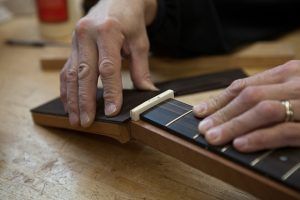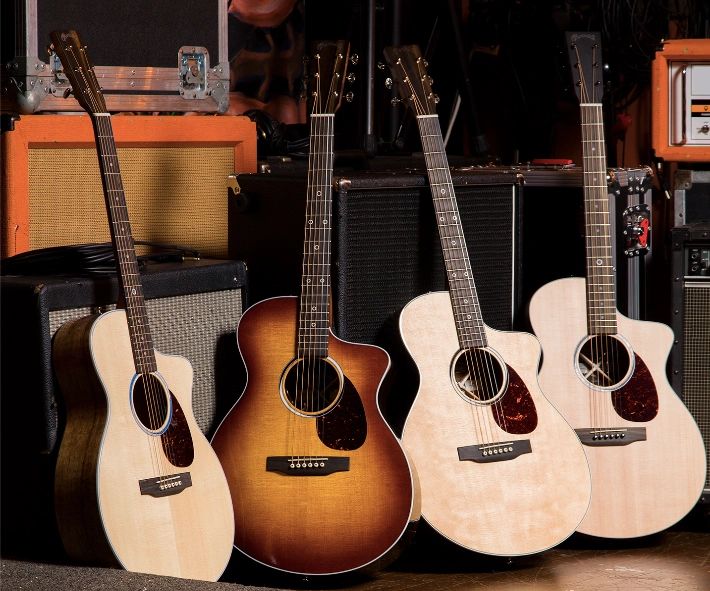
If you’re dealing with hand pain and arthritis, it can make everyday tasks more challenging and throw new hurdles into mastering the guitar. But the good news is you can still comfortably play the guitar with hand pain, but requires finding the right instrument to meet your needs.
Here’s a look at what to consider when choosing the best acoustic guitar for arthritic hands and how to make the best choice for you.
Can Playing Guitar Cause Arthritis?
Arthritis causes inflammation in one or more joints and can lead to pain and stiffness that often increase with age. There are several types of arthritis that range in severity, but most forms are thought to be caused by an issue with your immune system, causing the body to attack healthy tissues in the joint. There’s also a possible genetic link to arthritis.
Now for the good news. There’s no evidence that playing the guitar will cause arthritis or even make it worse. Instead, it could actually help ease the pain and help you adapt to hand mobility challenges.
Some people may feel pain from playing if they’re not adequately stretching their fingers or are using a guitar that is a poor fit for their condition. For example, a guitar with the wrong neck profile for your needs or string placement could make it harder to play and aggravate strain or hand fatigue.
Factors to Consider When Choosing a Guitar for Arthritis

Everyone’s experience with arthritis and playing an instrument is unique, but there are a few things to look for when choosing the right guitar for arthritis.
Neck Width and Shape
Neck width and shape can dramatically impact how easy it is to play the guitar, with or without arthritis. However, you may get conflicting answers on which neck profile works best.
Musicians with larger hands usually lean towards wider, thicker necks that are easier to hold and manage. Guitar players with smaller hands and beginners often prefer thinner, slimmer neck profiles that are easier for their fingers to glide across. If you have arthritis, a slimmer neck profile is often the preference, but it also depends on your hands, the severity of your pain, and what kind of music you want to play.
String Action and Gauge
Choosing a guitar with high action and thick gauge strings is usually challenging because you have to push down on the frets to produce the sound you’re looking for. Instead, opt for lighter strings with a slightly closer placement, making them easier to navigate.
The type of strings you use can also have an impact when playing guitar with arthritis. Steel strings are tougher to push down on firmly enough, while nylon, carbon-coated, and similar options are easier to manage.
Weight and Size of the Guitar
It makes sense that the weight and size of your guitar need to accommodate your physical limitations and comfort levels. Most guitar players with arthritis want something smaller and lighter, although there are cases where it may feel better to play something larger. For example, if you usually sit while playing the guitar, it may feel better on your hands to have a larger instrument that you can drape your arm over.
Best Acoustic Guitars for Arthritis
Some guitar brands are better suited for arthritis than others. Here’s a rundown of where to start on your journey.
Taylor Guitars
Taylor Guitars are known for being one of the easiest guitars to play due to their slimmer neck profile. Most people, especially players with smaller hands, appreciate Taylor’s comfortable, easy playability and being able to glide along the frets. Taylor also produces some mini guitars with ergonomics and sizes that may prove more comfortable when playing guitar with arthritis.
Taylor GS Mini-e Koa Plus
The Taylor GS Mini-e Koa Plus is a scaled-down Grand Symphony model with a solid Hawaiian koa top and sides for a vibrant and punchy tone. Its slimmer neck and low action make it easy to hold, especially if you have arthritis or smaller hands.
Taylor GT 811e
The Taylor GT 811e features six strings with a Sitka spruce top and Indian rosewood back and sides. With a scaled-down GT acoustic body shape, its C-Class bracing adds volume to give this smaller model more of a punch. It’s easy to hold and start playing right out of the box.
Baby Taylor Series Guitars
The Baby Taylor Series is an excellent guitar for beginners and those with arthritis for a full sound and portable size that feels comfortable while playing. However, if you have a large stature, it may feel too small, especially when trying to play a gig onstage.
Zager Guitars

Zager Guitars creates beginner-friendly, intermediate-level, and performance-level guitars. Unlike other guitar brands on the market, Zager Easy Play Custom Guitars are designed for players with arthritis, hand problems, smaller hands, or anyone who can’t find a comfortable fit on the market.
Zager’s neck profiles are slim from front to back and offer a more natural fit in your hands. Beyond the neck itself, Zager takes a unique approach to their strings. Their carbon-coated pillow touch strings and a custom string height are slightly closer together to create a more comfortable and easy playing experience.
ZAD80 Series (Solid Cedar/Rosewood Acoustic & Electric Pro)
Zager has produced its 80 Series for over three decades that are perfect for the stage, studio, or at home and a go-to option for veteran players. It boasts a mellow, sweet sound for a legendary performance. Its unique neck and neck placement create a comfortable fit when playing guitar with arthritis.
ZAD 50 Series (Play ZAD50 Solid Spruce/Mahogany Acoustic & Electric)
This handmade guitar is often compared to the Martin D18 and Taylor 5 Series, but at a friendlier price point and with easier playability. In 2020, the Zager Guitar team added a detailed ivory zipper stripe binding and installed a new 2020 Fishman Presys II electronics system.
ZAD 20 Series (Solid Spruce/Mahogany Acoustic & Electric)
Zagers’ series of no-frills guitars holds its own with more expensive models and sounds like the stuff the pros use. Whether you’re managing arthritis or have smaller hands, their unique neck profile, and carbon-coated strings make them a winner.
You can review all of Zager Guitars’ easy-play series here.
Yamaha Guitars
Although not explicitly designed with arthritis or hand pain in mind, Yamaha Guitars are comfortable and easy to play. They’re often recommended for beginners with smaller hands. Players praise Yamahas for being comfortable to play, even during long sessions, and holding their own against more expensive brands.
Yamaha C40 (and C Series)
The Yamaha C40 is a classical guitar with superb sound and comfortable playing ability. Its shorter neck and nylon strings make it easier to manage than other guitars with steel strings.
Yamaha FG830
Yamaha’s FG830 model features a rosewood back and sides with improved sound. Its slimmer body is ideal for intermediate- to upper-level players who enjoy finger-picking. A C-set neck feels comfortable in your hands and is a good pick for anyone looking for an easy-to-play guitar.
Yamaha FG800
The Yamaha FG800 is a standard acoustic guitar with traditional aesthetics and a solid spruce top. It’s known as one of Yamaha’s easiest-to-play guitars; however, the string action is higher than most, making it harder for a smooth sound if you’re having an arthritis flare-up.
Gibson Guitars
Gibson Guitars are well-regarded as a global brand and comfortable to play. Many players consider them more accessible than brands like Fender because of their looser string tension. However, Gibsons do come at a higher price point, and you can find similar comfort with a less expensive but just as reputable brand.
Gibson J 45 Studio Rosewood
With a solid rosewood back and sides, the Gibson J 45 Studio Rosewood features a slim neck that makes it comfortable for long practices and gig sessions. Its velvety, smooth sound pairs well with classic folk, rock, or blues.
Gibson SJ-200
The Gibson S-J-200 has been referred to as the “King of the Flat-Tops” since 1937 for its striking features and elegant shape. The body may feel more oversized than other options out there, but it sits comfortably on your knee while sitting down for a jam session.
Gibson L-00 Standard
The Gibson L-00 Standard has a long history since launching in the 1930s and becoming an industry staple. Its smaller size makes it easier to handle when you’re experiencing arthritis pain, although larger hands may find a different model more comfortable.
Blueridge Guitars
Sold under the company Saga Music, Blueridge Guitars are chosen by guitar players with arthritis for their comfortable bodies and slim necks that make them easy to hold and play. With narrow, fast-playing neck profiles, you should feel at ease picking up a Blueridge.
Blueridge BR-163
The more petite body on the Blueridge BR-163 makes it easier to handle and also features a slim, fast-playing mahogany neck. This guitar gets bonus points for being visually pleasing to look at with snowflake fingerboard inlays and an eye-catching headstock.
Blueridge BG-140
The vintage-style Blueridge BG-140 features a shorter scale, making string bending easier than most options. It’s easy to hold on stage or while sitting down and practicing for long stretches.
Martin Guitars

Martin Guitars offers renowned playability with models that are easy to hold and navigate. Their comfortable neck profiles and the distance between the strings and fretboard make playing the guitar with arthritis and related flare-ups easier.
Martin LX1E
The Martin LX1E features a spruce top and mahogany laminate construction and travels well for playing out or on vacation. The smaller size makes it easier to play, and its modified, low oval neck makes it comfortable to hold.
Martin SC-10E
If you’re having issues reaching the high notes while playing guitar with arthritis, the Martin SC-10E could be a good pick. It features a patented neck system that helps you access all of its frets to reach even the highest notes. It also features a low-profile velocity neck barrel for more comfortable playability.
SC-13E Special
The SC-13E Special promises to help you play longer and harder all the way up the guitar. Its neck allows easy access to even the highest frets, giving you the comfort you’re looking for during an arthritis flare-up.
Which Guitar Should You Pick for Arthritis?
Picking a guitar that feels comfortable, even with arthritis, is often a personal preference. Each player will also have a different experience holding a guitar and figuring out if it’s comfortable enough to play for their condition. Everyone’s threshold for pain is also different, making it difficult to determine if one instrument will feel better than another.
However, some guitar brands are better suited for guitar playing with arthritic hands than others. For example, classical guitars are also a good match for their nylon strings and more comfortable playability, but they may not align with the type of music you want to play.
Our pick is Zager Guitars because their easy-play system, practically invented for arthritis, unique carbon-coated pillow touch strings, and custom string height are all designed with hand pain and guitar playing with arthritis in mind. Zager Guitars helps you save money by selling directly to the consumer, but they also offer two-way, free shipping, so you can try it out risk-free.
Other Considerations for Choosing the Best Guitars for Arthritis
Beyond choosing a comfortable guitar for arthritis, you should also consider factors to make playing more enjoyable. Spend some time warming-up your hands and paying attention to dietary choices that could cause inflammation before playing. Choosing slower musical styles to warm-up could help, as could pulling up a comfortable chair to support your posture and position while playing.
Choosing a guitar with a lower string action can also help reduce hand pain. The idea is to lower your strings closer to the fret or invest in a guitar that is already outfitted the way you want. You can also try substituting open chords for barre chords to reduce challenges while playing. Switching to lighter strings that are easier to hold down could help soothe your arthritis. Some brands specialize in string selection, including Zager which uses carbo-coated strings placed slightly closer together to make playing easier.
Depending on how long you’ve played the guitar, you could also change up your dominant hand. For example, if you’re new to playing guitar and are right-handed, you could learn to play with your left hand if it helps reduce your pain. Some people only experience arthritis in one hand or specific joints, leaving the other hand pain-free.
Finding a guitar teacher specializing in hand pain or arthritis is also wise. Beyond having empathy for your condition, they should also have suggestions and strategies on how to adapt your technique (or the guitar itself) to make playing more enjoyable.
Additional Arthritis Resources
The technology around guitar playing and arthritis has evolved over the past decade with new gadgets, devices, and tips for guitar playing with arthritic hands. There are also more mainstream musicians than ever who are open about their diagnoses and challenges playing the guitar. To help reduce the pain and obstacles involved with arthritis, here are some resources to make guitar playing easier.
Rock-iT Barre
Devices like Rock-iT Barre mounts directly to your finger so you can press against the fretboard to form chords, similar to how you traditionally play the guitar. You’re not pressing any buttons and can still feel your way around the guitar as you play. You can also use it for open guitar strumming and picking patterns.
However, depending on the guitar you choose, you may not need an extra device. For example, the nylon strings on classical guitars or Zager Guitars carbon-coated strings are easy to press and turn while playing.
Wrist Straps
Guitar wrist straps help support your wrist and offer comfort while playing the guitar. However, they may or may not work, depending on what areas your arthritis is impacting and the severity of your pain. Some people also use wrist straps for carpal tunnel syndrome and tendonitis.
Thumb Pick
If you enjoy using a pick, you probably struggle with gripping it during an arthritis flare-up. Instead, you can look for a grip-less thumb pick specifically designed for players with hand pain or related issues.
A thumb pick gives you the option to keep your thumb free and easy for the three thickest strings while also using the rest of your finger for the rest. Or you can modify the way you play and rely on your thumb pick to help manage your arthritic hand while playing guitar.
Famous Guitar Players Who Have Arthritis

If you need some encouragement to keep going with your guitar-playing journey, here’s a roundup of world-class musicians dealing with arthritis.
Keith Richards
Keith Richards shot to fame with the Rolling Stones during the 1960s and 1970s and continues to rock out, even with arthritis. Richards adapted to using a 5-string guitar instead of the standard six and practices to help reduce pain and continuously refine his craft. He’s still a legendary guitarist and is often regarded as one of the all-time best, with inductions into the US Rock Hall of Fame and the UK Music Hall of Fame.
John McLaughlin
John McLaughlin forged a career during the 1960s in London and eventually became a globe-trotting jazz guitarist. After announcing his retirement from live performances in 2017, he reported feeling pain-free, crediting meditation and focus while continuing to play, record, and perform.
Les Paul
Renowned guitarist Les Paul was a jazz, country, and blues guitarist and one-time luthier who was the inspiration for Gibson’s namesake model. He dealt with arthritis for decades, making some of his fingers unusable, yet he continued playing. As if arthritis wasn’t enough, his right arm was also bent at a 90-degree angle after a car wreck in 1948 left him with screws throughout his limb. Despite the obstacles, Les Paul credits overcoming arthritis with the right mindset and learning to adapt to find ways to overcome his limitations.
Next Steps
Beyond finding just the right guitar, it’s always a good idea to consult a doctor or physical therapist before making any significant changes to your life. They may have additional recommendations or treatments to help ease your symptoms.
Playing guitar with arthritis can prove challenging, but it shouldn’t make or break your experience. There are plenty of guitar options, like Martin or Zager easy-play guitars, to choose from. Adding devices and thumb picks can also help bring more comfort and enjoyment to your hobby or musical aspirations.
